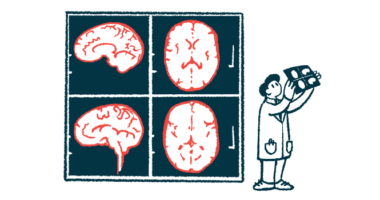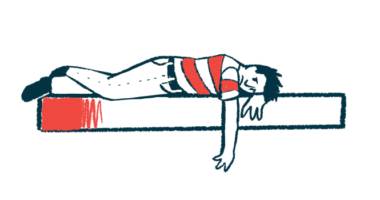Santhera: Agamree poised to be ‘corticosteroid of choice’ for DMD
The therapy was approved by the FDA in October for patients 2 and older

In October, the U.S. Food and Drug Administration (FDA) approved Agamree (vamorolone) for treating Duchenne muscular dystrophy (DMD) patients ages 2 and older, offering them a more tolerable, but similarly efficacious, oral corticosteroid option.
Clinical trial evidence indicates Agamree might ease muscle damage and minimize the side effects that cause many patients to lower their standard corticosteroid doses or stop using them altogether such that its developers believe the new corticosteroid therapy,“should become the corticosteroid of choice,” according to Shabir Hasham, MD, chief medical officer at Santhera Pharmaceuticals, one of the companies involved in Agamree’s development.
Agamree is being marketed in the U.S. by Catalyst Pharmaceuticals.
In a written Q & A with Muscular Dystrophy News Today, Hasham discussed the clinical trial data that backed Agamree’s U.S. approval, the ongoing studies to confirm its benefits, and what it all means for DMD patients going forward.
Corticosteroids, also called glucocorticoids, aim to reduce inflammation by mimicking the actions of the hormone cortisol, the body’s main naturally occurring glucocorticoid. This class of medications, which includes prednisone, is a standard-of-care for preventing muscle damage in DMD and is widely prescribed for many other inflammatory conditions.
Corticosteroids don’t have a favorable side effect profile, especially when used long-term, however. They’re linked to weak and fragile bones, stunted growth, weight gain, behavioral changes, skin problems, and delayed puberty, among other issues.
“DMD patients rely on treatment with glucocorticoids such as prednisone, but they are accompanied by a host of side effects,” Hasham told Muscular Dystrophy News Today. The high burden of these side effects are “reasons for down titrating [dose-lowering] or discontinuing treatment.”
What makes Agamree different?
Agamree is a corticosteroid too, but it’s one that “retains the properties that provide steroids with efficacy while evading other properties that cause detrimental side effects,” according to Hasham. In other words, it’s a dissociative steroid that’s structurally similar to prednisone, giving it “corticosteroid like efficacy,” but engineered in ways that avoid activating signaling pathways linked to side effects.
It’s able to do this in two distinct ways, Hasham said.
First, Agamree binds more weakly than standard corticosteroids to certain places on glucocorticoid receptors, a type of receptor protein through which cortisol and its lab-made counterparts exert their effects. As such, the activation of genes responsible for hormonal changes that drive corticosteroid-associated side effects is lower with it.
Moreover, most corticosteroids interact with an enzyme called 11-beta HSD that helps convert them to an active state, thereby amplifying their effects in the muscle, bone, brain, and kidneys, which can contribute to side effects.
Agamree doesn’t interact with this enzyme, and as such, “does not get amplified at local tissues, such as bone,” Hasham said.
Clinical evidence from the VISION-DMD trial (NCT03439670) and other open-label studies support that these mechanisms indeed lead to a more favorable safety profile.
VISION-DMD, which largely supported the FDA application, enrolled 121 boys with DMD who could walk, ages 4-6. They were assigned to oral Agamree (2 or 6 mg/kg), prednisone (0.75 mg/kg), or a placebo once daily for about six months, after which all received Agamree for another six months.
Agamree was found to have similar efficacy as prednisone for improving muscle function after six months compared to a placebo, but with fewer side effects. Particularly, unlike participants on prednisone, Agamree-treated patients didn’t see delayed growth.
“Agamree may be able to slow down muscle degeneration and prolong the ability to walk in DMD patients, without causing the growth stunting associated with the use of standard corticosteroid therapy,” Hasham said.
Fewer side effects with Agamree
Reductions in bone metabolism — the process of maintaining a balance between new bone growth and resorption of old bone — and bone mineralization, where bones are filled with the minerals that help keep them strong, is also seen with corticosteroids and can contribute to weak bones that easily fracture.
Agamree was able to prevent these reductions in the spine after about a year of treatment. According to Hasham, “this may translate into a reduction in the risk of bone fractures, which we are currently collecting longer-term data to confirm.”
Agamree has also been associated with fewer and less severe behavioral problems relative to prednisone, which Hasham noted can be, “a significant issue especially in very young children,” and “can be very challenging to manage.”
When patients on prednisone switched to Agamree, many side effects were eased, but patients didn’t see any loss of efficacy. In VISION-DMD, those who switched saw a 30% reduction in side effects and a 60% reduction in side effects usually linked to corticosteroids.
Long-term studies are also exploring evidence that Agamree is able to ease or avoid other side effects that emerge with extended corticosteroid use, Hasham said.
What are the side effects of Agamree?
The most common side effects of Agamree are consistent with the known profile of corticosteroids and include cushingoid features — physical features associated with excess cortisol — psychiatric disorders, vomiting, weight gain, and vitamin D deficiency.
“We are working hard to better understand how to best manage these side effects and find an optimal dose of vamorolone that would allow for chronic use to maximise any potential benefit of continued treatment,” Hasham said.
No new side effects were associated with Agamree that haven’t been seen before with this class of medications.
“Across all of our clinical studies and expanded access programs, boys have been on Agamree for up to [seven] years. During this time all of the adverse events and side effects that we have observed are typical for corticosteroids,” Hasham said. “We have not observed any unusual or unexpected side effects to date.
Given the similar efficacy profile, Hasham believes these clinical safety and tolerability findings are “where we see Agamree may have distinct advantage,” relative to other corticosteroids. “We believe that Agamree will be better tolerated at a higher effective dose,” he said.
Indeed, most boys given Agamree could tolerate higher doses, relative to the dose reductions usually required for other corticosteroids, he said.
While not all patients will respond the same way to treatment, Hasham said analyses so far haven’t identified any specific patient subgroups at a particular risk of not responding.
Early preclinical evidence has also suggested Agamree antagonizes, or blocks, mineralocorticoid receptors, another type of receptor through which cortisol exerts its effects.
Certain treatments already approved to treat cardiomyopathy, a type of heart disease, in DMD patients work through this mechanism. That could mean Agamree might have the added benefit of protecting the heart.
“We are planning additional studies to confirm this effect in humans and will collect long-term data to assess if there is any potential for vamorolone to be cardioprotective,” Hasham said.
Changes in treatment on the horizon
The DMD treatment landscape is rapidly changing, with groundbreaking disease-modifying therapies such as Elevidys, a gene therapy, coming to the forefront. Unlike those treatments, corticosteroids don’t directly target the underlying cause of disease.
Still, Hasham believes corticosteroids are “a standard of care and will remain so for the foreseeable future.”
“Given that no treatment is curative and DMD will most likely be treated with therapies used in combination, our view again is that corticosteroids will remain as a standard of care,” he said.
Agamree is under regulatory review in the European Union (EU), with a decision expected by the end of the year. Such an authorization, which would cover all member states of the EU, Iceland, Liechtenstein, and Norway, would make it the first and only medicinal product to be fully approved by the European Medicines Agency for DMD.
Potential commercial launches of it in Europe, beginning with Germany, are planned for early next year, “allowing European patients [to] gain access to a treatment that overcomes the significant burdens associated with traditional steroid treatment,” said Hasham, who noted the possible benefits of Agamree’s “unique mechanism of action” extend beyond DMD to a “variety of inflammatory conditions that are tamed by steroids, but can also leave patients overwhelmed by side effects.”
A Phase 2 trial (NCT05166109) is evaluating the dissociative corticosteroid in men with Becker muscular dystrophy at a single site in Pittsburgh. It’s also being evaluated for a number of other pediatric conditions where prednisone is a standard-of-care, but its use is limited by side effects.
“Our intention is to demonstrate that Agamree can offer comparable efficacy with a better tolerability profile, thereby allowing patients to remain on corticosteroids for longer and delaying the escalation to more immunosuppressive therapies,” Hasham said.







